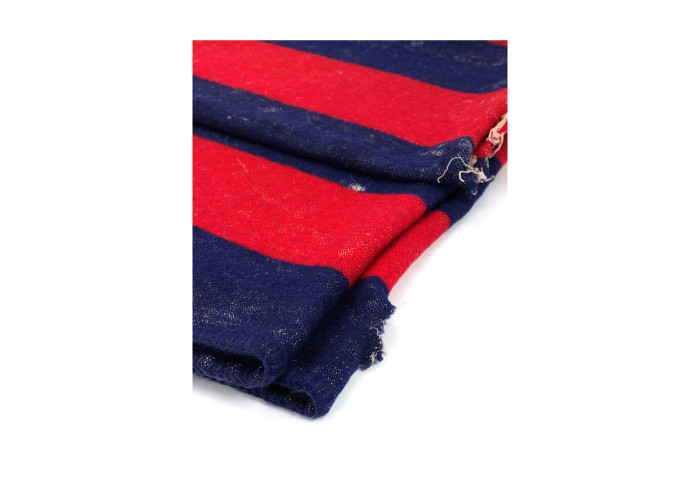Blanket of Major Tyrwhitt Drake
This is the blanket used on 17 June 1815, the night before the Battle of Waterloo by a British officer, Major Tyrwhitt Drake, to shield himself from the appalling weather. Despite the fact that the battle was fought in the middle of June, it rained torrentially throughout the night, and almost every soldier who fought at Waterloo was wet, cold, and sleep-deprived.
Thunderstorms and driving rain soaked the area around Waterloo on the night of 17 June 1815. British, French and German soldiers all described a night spent miserably searching for shelter in the sodden Belgian countryside. Some lit bonfires, some slept in peasants’ cottages, but Major Drake huddled under this horse blanket with his steed to keep warm. The blanket’s blue and red stripes are the colours of the Royal Horse Guards Regiment. Major George Simmons, 95th Rifles, described the conditions on the eve of Waterloo:
“The rain began to fall in torrents… The night was very bad. The field where we were was all mud. I got a bundle of straw to lie upon, and smeared an old blanket with thick clayey mud, which prevented the rain from passing through, and kept me tolerably warm.”
Different soldiers had other strategies for surviving the night. Private William Wheeler, of the British 51st Regiment of Foot, was “wet to the skin, but having plenty of liquor we were to use an expression of one of my old comrades “we and comfortable”.
The downpour continued until dawn, and turned the battlefield of Waterloo into a quagmire of thick mud. The crops in the fields were also soaking wet, forcing soldiers to push through chest-high waterlogged rye, and exhausting even the horses. The wet clay made cavalry charges difficult and cannons less effective, because cannon-balls got stuck in the earth. These conditions slowed the deployment of both armies, delaying the start of the battle. The French attack did not begin until almost mid-day, after troops had trickled back to their regiments from the various camps and bivouacs where they had spent the night. This delay would prove disastrous for Napoleon, as it gave the Prussian army time to arrive at the battlefield and join the fight against the French.
-
Curatorial info
- Originating Museum: National Army Museum
- Accession Number: NAM. 2011-06-27
- Material: Wool
- Technique: Knitted
-
Use this image
You can download and use the high resolution image for use in a non-profit environment such as a school or college, provided you give attribution to the copyright holder. Link to licence.
- Rights Holder: Copyright National Army Museum.
- License Type: Creative Commons
Find it here
This object is in the collection of National Army Museum











